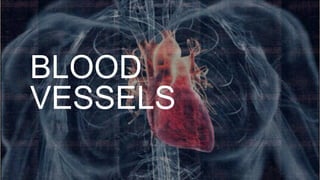5.1 Blood Vessels.pptx
•Download as PPTX, PDF•
0 likes•14 views
science 9
Report
Share
Report
Share

Recommended
More Related Content
Similar to 5.1 Blood Vessels.pptx
Similar to 5.1 Blood Vessels.pptx (20)
CARDIOVASCULAR SYSTEM (HEART AND BLOOD VESSEL).pptx

CARDIOVASCULAR SYSTEM (HEART AND BLOOD VESSEL).pptx
Describe the difference between a. The pulmonary and systemic circula.pdf

Describe the difference between a. The pulmonary and systemic circula.pdf
Cardiovascular System, Heart, Blood Vessel, ECG, Hypertension, Arrhythmia 

Cardiovascular System, Heart, Blood Vessel, ECG, Hypertension, Arrhythmia
our-group-presentation-about-earth_and_life-science.pptx

our-group-presentation-about-earth_and_life-science.pptx
Cape biology unit 2 -_circulatory_system_in_humans_and_exercise

Cape biology unit 2 -_circulatory_system_in_humans_and_exercise
Anatomy and physiology of the heart by Adeboye Oluwajuyitan

Anatomy and physiology of the heart by Adeboye Oluwajuyitan
More from Marben Melencion
More from Marben Melencion (19)
THIRD QUARTER Grade 4 Science-Pointers and Types of Tests

THIRD QUARTER Grade 4 Science-Pointers and Types of Tests
Nuclear Membrane: Active and Passive Transport (Illustrations)

Nuclear Membrane: Active and Passive Transport (Illustrations)
Recently uploaded
Recently uploaded (20)
Asymmetry in the atmosphere of the ultra-hot Jupiter WASP-76 b

Asymmetry in the atmosphere of the ultra-hot Jupiter WASP-76 b
Seismic Method Estimate velocity from seismic data.pptx

Seismic Method Estimate velocity from seismic data.pptx
SAMASTIPUR CALL GIRL 7857803690 LOW PRICE ESCORT SERVICE

SAMASTIPUR CALL GIRL 7857803690 LOW PRICE ESCORT SERVICE
pumpkin fruit fly, water melon fruit fly, cucumber fruit fly

pumpkin fruit fly, water melon fruit fly, cucumber fruit fly
High Profile 🔝 8250077686 📞 Call Girls Service in GTB Nagar🍑

High Profile 🔝 8250077686 📞 Call Girls Service in GTB Nagar🍑
Formation of low mass protostars and their circumstellar disks

Formation of low mass protostars and their circumstellar disks
FAIRSpectra - Enabling the FAIRification of Spectroscopy and Spectrometry

FAIRSpectra - Enabling the FAIRification of Spectroscopy and Spectrometry
Dopamine neurotransmitter determination using graphite sheet- graphene nano-s...

Dopamine neurotransmitter determination using graphite sheet- graphene nano-s...
Feature-aligned N-BEATS with Sinkhorn divergence (ICLR '24)

Feature-aligned N-BEATS with Sinkhorn divergence (ICLR '24)
Pests of mustard_Identification_Management_Dr.UPR.pdf

Pests of mustard_Identification_Management_Dr.UPR.pdf
5.1 Blood Vessels.pptx
- 2. WHAT IS A BLOOD VESSEL? Blood vessels are intricate networks of hollow tubes that transport blood throughout the entire body so that it can deliver valuable nutrients to and remove waste from cells via the cardiovascular system.
- 3. Blood is the circulating medium in the cardiovascular system. It flows continuously through the different types of blood vessels.
- 5. Arteries Veins Capillaries Flow of blood starts from the: heart, to the artery, to arteriole, to capillary, to venule, to vein, and goes back to heart.
- 6. The walls of arteries are thicker than veins to withstand pressure as the blood is being pumped throughout the body. Capillaries are extremely small vessels located within the tissues of the body that transport blood from the arteries to the veins. Fluid and gas exchange between capillaries and body tissues takes place at capillary beds.
- 7. Arteries –moves blood away from heart Veins –moves blood towards the heart Capillaries –connects arteries and veins as the blood in arteries gives off oxygen in body tissues and carries carbon dioxide as it travels to veins going back to heart
- 8. Arteries (red) carry oxygenated blood away from the heart to different parts of the body. Veins (blue) carry deoxygenated blood from different parts of the body going to the heart. Have valves to prevent backflow of blood.
- 9. The walls of blood vessels have coats or tunics, namely tunica interna (innermost coat), tunica media (central coat), and tunica externa (outermost coat). Arterial walls are strong enough to withstand the pressure of the blood coming from the heart. By contrast, veins withstand low blood pressure and thus have thinner walls.
- 10. NOTE: Arteries generally carry oxygenated blood (blood with oxygen), whereas veins carry deoxygenated blood (blood without oxygen). The flow of blood in the arteries is away from the heart, whereas in veins, the blood flows toward the heart. Thus, veins have valves to prevent the backflow of blood.
- 11. The pressure or force that blood exerts against the walls of the blood vessels. It rises and falls as the heart contracts and relaxes. Systolic pressure is the pressure in the arteries when the ventricles are contracting. Meanwhile, Diastolic pressure is the pressure in the arteries when the ventricles are relaxing. A blood pressure reading of 120 over 80 means a systolic pressure of 120 and diastolic pressure of 80. Stethoscope is used to detect blood pressure while sphygmomanometer is used to measure blood pressure.